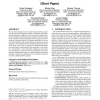ATAL
2008
Springer
14 years 2 months ago
2008
Springer
ATAL
2008
Springer
14 years 2 months ago
2008
Springer
Matchmaking is the process of introducing two or more agents to each other. Current matchmaking techniques are unidirectional and fail to address large-scale and highly dynamic sy...
ATAL
2008
Springer
14 years 2 months ago
2008
Springer
The functional characteristics of market-based solutions are typically best observed through the medium of simulation, data-gathering and subsequent visualization. We previously d...
ATAL
2008
Springer
14 years 2 months ago
2008
Springer
As computerized agents are becoming more and more common, e-commerce becomes a major candidate for incorporation of automated agents. Thus, it is vital to understand how people de...
ATAL
2008
Springer
14 years 2 months ago
2008
Springer
Fully autonomous vehicles promise enormous gains in safety, efficiency, and economy. Before such gains can be realized, safety and reliability concerns must be addressed. We have ...
ATAL
2008
Springer
14 years 2 months ago
2008
Springer
Life-like agents have the potential to make e-shopping sites on the Web more attractive and persuasive; our interest is to determine how multiple life-like agents should behave as...
ATAL
2008
Springer
14 years 2 months ago
2008
Springer
When autonomous agents decide on their bidding strategies in real world auctions, they have a number of concerns that go beyond the models that are normally analyzed in traditiona...
ATAL
2008
Springer
14 years 2 months ago
2008
Springer
We study the problem of agents locating other agents that are both capable and willing to help complete assigned tasks. An agent incurs a fixed cost for each help request it sends...
ATAL
2008
Springer
14 years 2 months ago
2008
Springer
Distributed Constraint Optimization (DCOP) is a key technique for solving multiagent coordination problems. Unfortunately, finding minimal-cost DCOP solutions is NP-hard. We there...
ATAL
2008
Springer
14 years 2 months ago
2008
Springer
As computers inevitably begin to replace humans as the drivers of automobiles, our current human-centric traffic management mechanisms will give way to hyper-efficient systems and...




